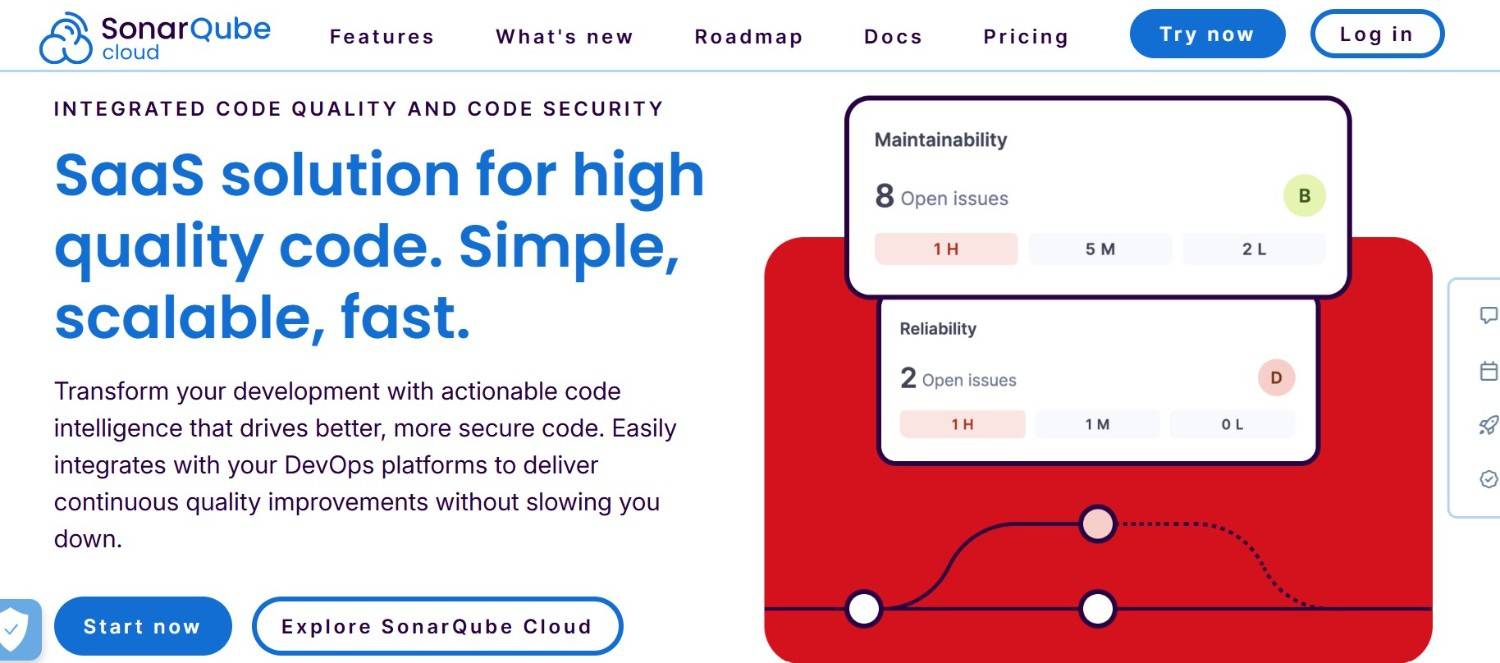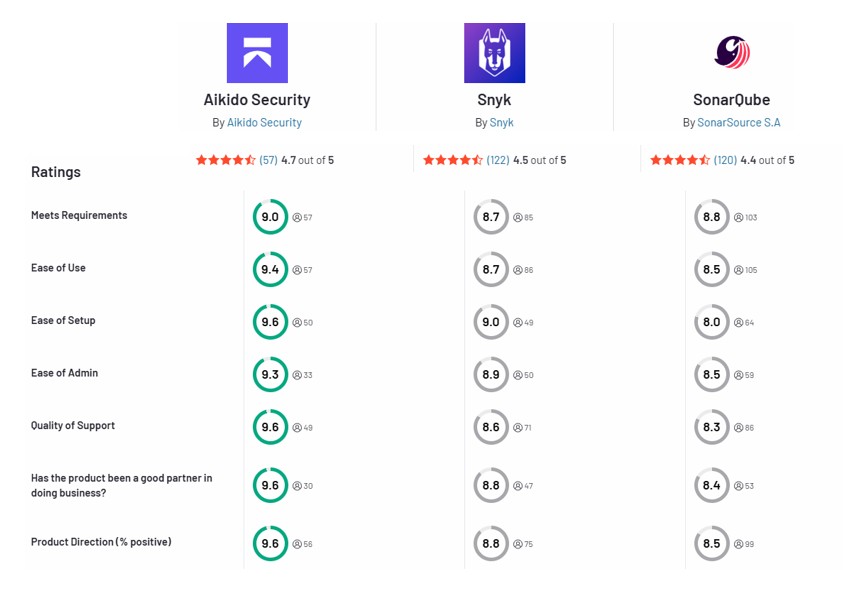Introduction
Snyk and SonarQube are both popular tools for improving code security and quality. However, they take very different approaches. In this comparison, we cut through the hype and examine each tool’s real capabilities, developer experience, and shortcomings – with a frank look at where each falls short and a better alternative.
TL;DR
Snyk and SonarQube both help secure your codebase, but they focus on different layers – and both have blind spots. Snyk is strong on open-source and container security, while SonarQube focuses on static code quality. Aikido Security brings both worlds together in one platform, with fewer false positives and simpler integration – making it the better choice for modern security teams.
Overview of Each Tool
Snyk: A developer-first security platform that automatically finds and fixes vulnerabilities in code, open-source dependencies, containers, and infrastructure as code. It’s known for easy integrations into development workflows and providing fix recommendations (like suggested dependency upgrades).
SonarQube: A longstanding static analysis tool that gives an “overall health” check of your source code. It flags code smells, bugs, and some security vulnerabilities to help teams maintain quality. SonarQube requires setting up a server (or using SonarCloud SaaS) to run analyses.
Feature-by-Feature Comparison
Security Capabilities
- Snyk: Offers broad application security coverage in one product. It includes SAST for code, software composition analysis (vulnerability scanning for open-source libraries), container image scanning, and even IaC security. Snyk focuses on known vulnerabilities and quick remediation – for example, it can automatically open fix pull-requests for vulnerable dependencies.
- SonarQube: Focuses on static code analysis of your own source code. It will catch things like SQL injection patterns or hardcoded secrets in code, but it does not scan third-party libraries for known CVEs (no built-in SCA). In short, SonarQube helps clean up your code; it won’t tell you if a dependency you use is vulnerable.
Integration
- Snyk: Designed for seamless integration into modern development pipelines. It plugs into repos (GitHub, GitLab, Bitbucket, etc.), CI/CD pipelines, and IDEs with minimal fuss. Developers can see security issues in pull requests or right in their editor. Because Snyk is cloud-based, there’s no heavy setup – you add it to your workflows and go.
- SonarQube: SonarQube also integrates with CI/CD and developer tools, but with more overhead. You must host a server (or use SonarCloud) and wire it into your build process. Setup and maintenance can be a headache for new teams, but once it’s running, SonarQube works smoothly (e.g., annotating PRs with issues).
Accuracy
- Snyk: When it comes to scan results, Snyk can produce some noise. Users have reported “excessive false positives” from Snyk scans that create unnecessary work. Its vulnerability database is strong (it rarely misses known critical issues), but you might spend time sifting out the truly relevant findings from the noise. On the plus side, Snyk’s reports tend to be actionable – each issue comes with details and guidance to fix it.
- SonarQube: SonarQube will flag some issues that aren’t actual problems (common for static analysis), so teams often adjust rules to filter noise. That aside, its findings are generally high-quality. One reviewer noted SonarQube’s false positive rate is relatively low compared to other SAST tools. You’ll still mark a few false alarms as “won’t fix,” but SonarQube provides code traces and examples that make triaging easier.
Coverage
- Snyk: Snyk covers many risk areas in one tool. It scans open-source dependencies across popular ecosystems, plus container images and IaC configs. For static code analysis, Snyk Code supports the major languages (Java, JavaScript/TypeScript, Python, C#, Go, etc.), though not every language. In short, it handles most modern tech stacks, but very niche or legacy languages might not be covered.
- SonarQube: SonarQube supports static analysis for nearly 30 programming languages, covering everything from modern languages to some legacy ones. It's highly versatile for diverse codebases. However, SonarQube's coverage is strictly limited to code— it won’t scan your containers, config files, or external libraries. Many teams pair SonarQube with a tool like Snyk to cover those third-party and infrastructure risks.
Developer Experience
- Snyk: Snyk generally gets praise for a good developer experience. It integrates into existing dev workflows, surfacing issues in familiar places (pull requests, IDEs, etc.). The interface is straightforward, and it even suggests fixes (like recommended dependency upgrades) which devs love. The main complaint is noise – if Snyk reports a huge list of issues, it can overwhelm teams trying to prioritize what's real.
- SonarQube: SonarQube is often seen as a helpful quality gatekeeper that nudges developers toward better code. It catches bugs and code smells, providing detailed examples that help devs learn. On the flip side, if you don’t tune Sonar’s rules, it may overwhelm you with minor issue alerts. Some devs also find it a chore to keep checking SonarQube’s interface (one more tool in the chain).
Pricing
- Snyk: Many consider Snyk expensive. There is a free tier for small projects, but costs climb steeply for larger teams and full features. Snyk typically charges per developer seat or project, which adds up quickly. In fact, some users feel the enterprise price "does not match the value provided". Bottom line: Snyk can put a serious dent in your budget.
- SonarQube: SonarQube’s Community Edition is free for basic code scanning. The paid editions unlock advanced security rules and more language support, and they charge by the number of lines of code analyzed. That can get expensive for very large codebases. On the other hand, a single SonarQube license covers the whole team (no per-developer fees). In practice, small projects can use SonarQube cheaply (or freely), but at enterprise scale the licensing costs add up.
Aikido offers a simpler, more transparent pricing model – flat and predictable – and is significantly more affordable at scale than either Snyk or SonarQube.
Pros and Cons of Each Tool

Snyk – Pros:
- Comprehensive security coverage (code, open source, containers, IaC) in one platform, so you don’t need separate tools for each.
- Excellent integration into developer workflows (CLI, Git repos, CI pipelines, IDE plugins), making it easier for devs to actually fix issues.
- Helpful remediation info and automated fixes – Snyk can suggest version upgrades or even submit PRs to address vulnerabilities.
- Free tier available for trial and small-scale use (great for open-source projects).
Snyk – Cons:
- Can overwhelm you with false positives or low-priority alerts, creating “alert fatigue” for developers.
- High pricing for full-featured use in larger teams; many feel the cost ramps up too fast.
- Some users report the support experience can be slow or unhelpful if you run into problems.
- Primarily a cloud service – on-premises options exist but are not the norm, which may not suit organizations with strict data policies.

SonarQube – Pros:
- Strong at improving code quality and catching bugs early. It systematically enforces good coding standards (less tech debt over time).
- Supports a wide array of languages and tech stacks, which is great for polyglot teams or older codebases.
- Smooth CI/CD integration for quality gates – it can break the build if new code introduces issues, helping keep standards high.
- Offers a free version, so teams can start using it at no cost. Even paid plans are one license for the whole team (no per-user cost), which can be economical for some cases.
SonarQube – Cons:
- Limited scope in security – it doesn’t check open source dependencies for known vulns and doesn’t cover runtime or environment security.
- Requires infrastructure and maintenance effort. Hosting the server, managing database and upgrades, etc., take time (which small teams might lack).
- Tends to flag a lot of minor issues out-of-the-box. Without tuning, you might get many “false alarms” that developers feel are noise.
- Advanced security rules and features are only in paid editions, so the free version might not satisfy strict AppSec needs.
Aikido Security: The Better Alternative

Aikido Security is a newer platform that positions itself as the “no-bullshit” alternative to both Snyk and SonarQube. It combines the key capabilities of these tools into one solution, covering SAST, SCA, DAST, container scanning, secret detection, cloud configuration, API security testing, and more. In other words, Aikido aims to be a one-stop shop for application security (11 tools in one) so you don’t have to juggle multiple products.
Aikido eliminates common developer pain points with smart automation that drastically reduces false positives and highlights real risks. It’s fast to set up, integrates cleanly with CI/CD and IDEs, and offers responsive support.
Pricing is transparent, with a generous free tier and no per-seat or LOC-based fees. If you're tired of noisy alerts, tool sprawl, or rising costs with tools like Snyk or SonarQube, Aikido is a streamlined, no-nonsense alternative.
Start a free Trial or request a demo to explore the full solution.



.avif)
